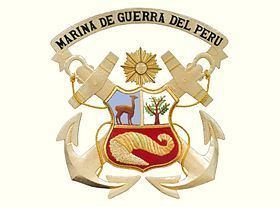Active 8 October 1821 - today Naval Headquarters Callao Naval Base Founder José de San Martín Branch Navy Allegiance Ministry of Defense | Country Peru Patron Miguel Grau Seminario Founded 8 October 1821 Fleet 6 | |
 | ||
Size 25,988 active personnel
51 ships, 33 aircraft Anniversaries October 8 - Navy's Foundation Day and Anniversary of the Battle of Angamos Engagements War of the Pacific, Chincha Islands War Similar Peruvian Air Force, Peruvian Army, Chilean Navy, Argentine Navy, Colombian Navy Profiles | ||
The Peruvian Navy (Spanish: Marina de Guerra del Perú, abbreviated MGP) is the branch of the Peruvian Armed Forces tasked with surveillance, patrol and defense on lakes, rivers and the Pacific Ocean up to 200 nautical miles (370 km; 230 mi) from the Peruvian littoral. Additional missions include assistance in safeguarding internal security, conducting disaster relief operations and participating in international peacekeeping operations.
Contents
- marina de guerra del per peruvian navy 2017 hd
- History
- Organization
- Bases
- Ranks
- Naval Aviation
- Naval Infantry Brigade
- Other units
- Peacekeeping operations
- Future orders
- References
The Marina de Guerra del Perú celebrates the anniversary of its creation in 1821 on October 8 and also commemorates the decisive Battle of Angamos, the final part of the naval campaign of the War of the Pacific between Peru and Chile at the end of 1879.
marina de guerra del per peruvian navy 2017 hd
History
The Marina de Guerra del Perú was established on 8 October 1821 by the government of general José de San Martín. Its first actions were undertaken during the War of Independence (1821–1824) using captured Spanish warships. Shortly afterwards it was engaged in the war against the Gran Colombia (1828–1829) during which it conducted a blockade against the seaport of Guayaquil and then helped with the occupation of this city by Peruvian forces. It saw further action during the wars of the Peru-Bolivian Confederacy (1836–1839) and during the Chincha Islands War with Spain (1866). The breakout of the War of the Pacific (1879–1883) caught the Peruvian Navy unprepared and with inferior forces in comparison with the Chilean Navy. Even so, hit-and-run tactics carried out by Peruvian Admiral Miguel Grau, commander of the ironclad Huáscar, delayed the Chilean advance by six months until his death and defeat at the Battle of Angamos.
After the war, the Peruvian Navy had to be rebuilt from the ground up. In 1900 the force amounted to only one cruiser of 1,700 tons displacement, a screw-driven steamer, and ten smaller ships - the latter described by a contemporary British publication as "of no real value". The lengthy process of expansion and rebuilding started in 1907 with the acquisition in the United Kingdom of the protected cruisers Almirante Grau and Coronel Bolognesi, followed by the arrival of two submarines, Ferré and Palacios, from France in 1911. During the Presidency of Augusto B. Leguía (1919–1930) a Navy Ministry was established as well as a Navy Aviation Corps, both in 1920. Border conflicts with Colombia in 1911 and 1932 and a war with Ecuador in 1941 saw Peruvian warships involved in some skirmishes in support of the Army. The attack on Pearl Harbor brought World War II to the Pacific and even though Peru did not declare war on the Axis until 1945, its Navy was involved in patrol missions against possible threats by the Imperial Japanese Navy from early 1942 up to mid-1945. During the 1970s and the first half of the 1980s the Peruvian Navy carried out a major buildup programme which allowed it to take advantage over its traditional rival, the Chilean Navy. This proved to be temporary because the economic crisis of the second half of the 1980s forced the decommissioning of several warships and resulted in a general lack of funds for maintenance. The economic upturn of the 1990s and 2000s has permitted some improvement although at a reduced force level compared to the early 1980s.
Organization
The current Commander-in-Chief of the Peruvian Navy is Admiral Carlos Tijeda. Naval Forces are subordinated to the Ministry of Defense and ultimately to the President as Commander-in-Chief of the Peruvian Armed Forces. They are organized as follows:
Operational units are divided between three commands:
Pacific Operations General Command, it comprises the following units:
Amazon Operations General Command, tasked with river patrolling in the Peruvian portion of the Amazon Basin.
Coast Guard, tasked with law enforcement on Peruvian territorial waters, rivers and lakes.
Bases
Although most of the fleet is based at Callao, this is not considered an ideal location because it is also the main outlet for Peruvian trade, causing space and security problems. During the 1980s the building of a new naval base at Chimbote was considered but high costs and a bad economic situation made the project unfeasible.
Ranks
Naval Aviation
The Naval Aviation Force ((Spanish): Fuerza de Aviación Naval, AVINAV) is the air branch of the Peruvian Navy, its roles include anti-submarine warfare, anti-surface warfare, maritime surveillance, reconnaissance and transport of marine personnel. It is also responsible for airborne operations of the Peruvian Marines.
Naval Infantry Brigade
Other units
Peacekeeping operations
The Peruvian Navy has been actively involved in several United Nations Peacekeeping Operations. As of June 2006 Naval Infantry and Special Operations troops have been deployed to United Nations Peacekeeping Force in Cyprus (UNFICYP) (embedded in the Argentine forces ) and United Nations Stabilization Mission in Haiti (MINUSTAH). Peruvian naval officers have also been deployed to United Nations Organization Mission in the Democratic Republic of the Congo (MONUC), United Nations Operation in Côte d'Ivoire (UNOCI), United Nations Mission in Sudan (UNMIS) as United Nations Militar Observers (UNMOs). By 2012 the Peruvian Navy sent its first officer to serve in United Nations Interim Security Force for Abyei.
